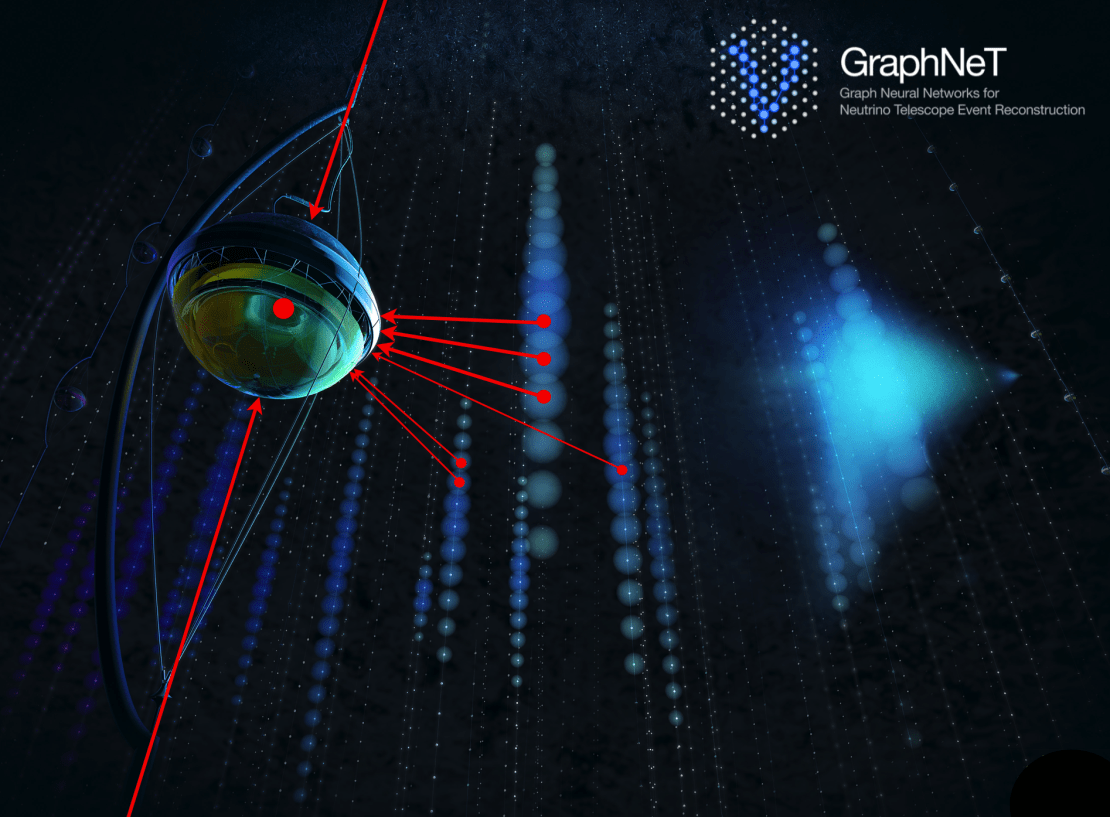Machine learning (ML) has proven to be an invaluable tool for data analysis, including the field of particle physics. Now, ML techniques are being employed to analyze data collected by the IceCube Neutrino Observatory, a cubic-kilometer array of optical sensors buried in Antarctic ice that detect neutrinos, ghostly subatomic particles that act as cosmic messengers.
When a neutrino interacts with a molecule of ice, it produces secondary particles that emit blue light, which is then detected by IceCube as an “event.” In a process called reconstruction, the signals or light patterns are used to determine which type of neutrino caused the event as well as its direction and energy. However, one of the barriers to reconstructing these events is the irregular properties of the ice and detector itself, which has made it even difficult to apply more conventional ML algorithms.
That is where a new ML paradigm comes in.
In a technical paper recently published in the Journal of Instrumentation, the IceCube Collaboration presents an all-purpose algorithm trained to recognize IceCube neutrinos—and determine their type, where they came from, and how much energy they carry—using a new ML paradigm called graph neural networks (GNNs). What makes GNNs different is that they use graphs, a mathematical tool that makes it easy to describe connections between objects.
For the method, the collaborators considered a recorded signal in each detector unit as a node that can be connected to nearby nodes, thereby representing IceCube events as a graph. They were then able to use a GNN to determine the type of event. And in case it was a neutrino, the GNN could also be used to determine the energy and direction of such a neutrino candidate. Finally, the GNN method was capable of also classifying different neutrino event types such as tracks (straight path) or cascades (outward expanding) very efficiently.
A framework called “Graph Neural Networks for Neutrino Telescope Event Reconstruction” (GraphNeT) was developed by Andreas Søgaard, a Marie Curie Fellow at the Niels Bohr Institute at the University of Copenhagen, and Rasmus Ørsøe, a PhD student at the Technical University Munich (TUM), both leads on the study along with Troels Petersen, an associate professor of experimental particle physics at the Niels Bohr Institute, TUM PhD student Martin Ha Minh, and TUM postdoctoral associate Philipp Eller.

“GraphNeT is intended to be a one-stop shop for development and deployment of GNN-based solutions to all neutrino experiments, such as IceCube, KM3Net, and Juno,” said Ørsøe. “By using modern code standards and providing proper documentation, we increase the reusability of individual code contributions and lower the technical threshold for those who would like to apply them, in total increasing the science output of the relevant experiments.”
For the present study, researchers showcased the GraphNeT algorithm dynedge (dynamical edges), which works directly on graphical representations of the detector responses from neutrino interactions to best represent the event topology. The collaborators gave dynedge a set of tasks to test its ability to classify events and discriminate between muons—a type of subatomic particle 207 times heavier than an electron—and neutrinos. Overall, the collaborators found a significant improvement in reconstruction compared to current state-of-the-art methods.
“We found that the GNN approach is more than 10,000 times faster than previous methods, while at the same time also slightly better at recognizing particle signals and determining their parameters,” said Petersen. While this is not a physics result in itself, we believe that our methods will improve the science of not only IceCube, but also of similar current and future experiments.”
Although the study focused on reconstruction, the collaborators note that the GNN approach can also be used to sort out neutrinos from background events or to classify neutrino interactions into different categories. The GNN paradigm also opens up new possibilities to search for new physics and provide cosmic alerts from low-energy neutrinos. As an added bonus, dynedge is compatible with the upcoming IceCube Upgrade and next-generation neutrino telescope, IceCube-Gen2, making it future proof.
“It’s an ongoing effort to identify areas of possible application and to provide the relevant benchmarks,” said Ørsøe.
+ info “Graph Neural Networks for Low-Energy Event Classification & Reconstruction in IceCube,” IceCube Collaboration: R. Abbasi et al., JINST 17 P11003 (2022), iopscience.iop.org, arxiv.org/abs/2209.03042